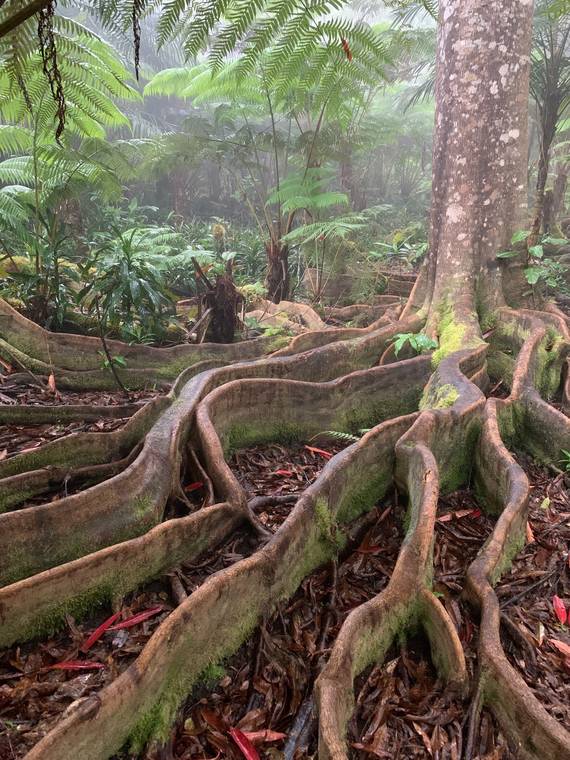The beginning of a new year and the death and destruction that occurred in 2020 teaches us that life in general goes in cycles. Madam Pele manifests this phenomenon as Kilauea erupts again. With thousands of acres covered with lava in the last few years, it is hard to imagine they will ever support vegetation again at least in our lifetime.
In heavy rainfall regions like Kapoho it only takes a few decades once the lava stops flowing. The process of healing can be more rapid with a little help from humans. Where rainfall is scant, it takes more effort.
Where weather conditions are dry, it is a good to explore ways to conserve water as well. Organic material is essential to healthy growing conditions. Decomposed organic matter helps increase water and nutrient holding capacity of the soil. Rotted material like leaves and clippings used as surface mulch can help conserve moisture and keep unwanted plants under control. Nematodes, those little microscopic worms that feed on plant roots, will do less damage in a high organic soil. Organic matter may also increase the minor element and microbiological activity of a new planting medium.
Technically what you are building on a young lava flow is not soil, but a growing medium to bring back life more quickly. For simplicity, we think of it as soil. However if you wander the upslopes Mount Hualalai or Kilauea where lush forests of ohia and hapuu are the common vegetation you will notice that the forest is actually growing on a shallow layer of organic matter. On further observation you will find is that these forests are thriving on lava flows as recent as two to six hundred years old.
Along the North Kona and South Kohala Coast where rainfall is not sufficient to allow forests to return, we humans have done an amazing job of creating urban forests by grinding the lava, adding topsoil, water and vegetation to create what it would have taken nature centuries to accomplish. Of course, the cost of such endeavors runs in to the multi-millions of dollars.
Without the resources to give life to large tracts of land, we can achieve the same effect using the resources at out disposal. For example, save your grass clippings and leaves. They are like money in the bank. You can store these materials in a corner of the garden.
Decay of plant material deposited in a compost pile can be hastened through the use of fertilizer and manures. For each bushel of leaves, grass clippings or other green waste, add two cups of balanced fertilizer like organic 8-8-8 and one cup crushed coral, dolomitic or hydrated lime. The compost is ready to use in about three months. It is an excellent material to mix with soil for vegetable gardens and new plantings.
Anthuriums especially thrive on compost. They love that high organic, mix with good water retention capability and yet good drainage. A good mix needs to be able to anchor the roots and stem so that the plant will not topple over as it grows upward yet provide sufficient moisture, nutrients, and aeration to the plant. Cinder or crushed rock added to composted wood shavings, sugar-cane bagasse, macadamia nut shells, peat or tree bark will serve to better anchor the roots.
Even with composting and mulching, you will still need to fertilize your garden. Some Hawaiian soils are very young and low in nutrients. Larger amounts of fertilizer are needed for growing plants and lawn grasses, than where soils are older and better developed.
The young soil is not only lacking in the primary elements, such as nitrogen, phosphorus and potassium, but it may be deficient in the minor elements like manganese, copper, zinc, and boron. When plants are grown in these mineral deficient soils and fertilized with ordinary plant foods, they often develop various diseases. Several years ago, plant doctors studied these deficiencies and learned not only how to recognize the affected plants, but also learned that they could be corrected by spraying with the mineral in which the plant was deficient.
But what average gardener has the training that enables him or her to recognize deficiency symptoms in plants? To overcome this problem, the nutritional spray was developed. It is a mixture that contains about all of the minerals in which a plant can be deficient. Some plants are more subject to mineral deficiencies than are others. Especially vulnerable to mineral deficiencies such as dieback, mottled leaf, small or deformed leaves and yellow leaves are hibiscus, gardenia, mock orange, ixoras, mangoes, avocados, macadamia, coffee and citrus.
In new gardens, it may be necessary to apply a nutritional spray about every three months for the first year in order to keep ahead of deficiencies.
Along with the nutritional spray, it is a good idea to use a soil application of other elements. Magnesium and sulfur are the most important, but occasionally we find plants with boron, manganese, copper and other trace element deficiencies. There are several combinations available at your garden supply store. Certain plants require larger amounts of the trace elements than other plants. As you get acquainted with our tropicals, you will find for example that iron is especially important on ixoras, hibiscus, azaleas, and gardenias or that magnesium keeps leaves of coconut and areca palms from becoming orange colored and dying prematurely. Zinc is the vital element in growing Queen palms, Royal palms and palms in the date group.
Increasing your soil organic matter and using minor element treatment as a spray or soil application or both will keep your plants from having these deficiencies under most conditions. Remember to follow directions on the label. Too much of the important plant nutrient materials can be as bad as than too little!
Next week we will focus in more detail on plant nutrients and how to use them.



